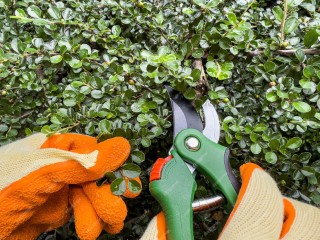Plant Pruning

Pruning is the selective removal of plant parts, including branches, buds, leaves, blooms and roots. It can involve the removal of living, dying or dead plant parts. Pruning applies to both soft-tissue (herbaceous) plants and woody plants (trees, shrubs, etc.). There is no “one way” of pruning plants. Proper pruning practices depend on many factors, including the type and health of the plant and the goal of the pruning.
The following are the primary reasons plants are pruned.
Maintaining Plant Health: Removal of dead, dying or infested plant parts and thinning out a canopy to allow more airflow and light penetration.
Training The Plant: To promote and create a certain shape, height or width of a plant. (lateral branching, or bushy compact form).
Improve Foliage & Stem Quality: Every time you prune a plant it becomes stronger, fuller, and more stable.
Restricting Hazard Growth: Removal of plant parts that pose a safety hazard, or may grow into a structure or object that can cause future damage.
Perennials to cut back or dead head in fall: Phlox, Bee Balm (Monardo), Golden Marguerite, Painted Daisy, Hardy Begonia, Yarrow (Achillea), Spike Speedwell (Veronica), Lady-bell, Helianthus, Astilbe, Columbine (Aquilegia), Japanese Anemone, Leopard Plant, Crocosmia, Daylilies (Hemerocallis), Hosta, Catmint (Nepeta), Salvia, Iris (Iris germanica), Blackberry Lily (Iris domestica), Ground Clematis, Corydalis.
Perennials not to cut back in fall: Coral Bells (Heuchera), Forsythia, Coneflowers (Echinacea), Azaleas, Rhododendrons, Black Eyed Susan (Rudbeckia), Roses, Ornamental Grasses, Ferns, Lilacs, Milkweed (Asclepias), Red Hot poker (Kniphofia), Cranesbill (Geranium), Stonecrop (Sedum), False Indigo (Baptista), Hydrangea.
When pruning flowering shrubs, think in terms of when the plant blooms. If the plant blooms later in the spring or in the summer, it may be okay to trim it now. Late-blooming plants typically make their flower buds during spring growth. Because of this, trimming in the fall usually won’t hurt them, since you aren’t removing already formed spring buds. A few examples of plants that can be safely trimmed include the Butterfly bush, caste tree, gardenia, and angel’s trumpet.
Bottom Line… Don’t trim spring-blooming plants in the fall. If you are not sure what or when to trim; ask an expert at your local garden center. Dead or dying plant parts are not only unattractive, but also harmful to the plant as they can provide food and shelter to harmful pests and diseases. If not attended, your plants will not flourish and could die.
Disclaimer: All the information on this website is published in good faith and for general information purpose only. gardencare1.com does not make any warranties about the completeness, reliability and accuracy of this information. Any action you take upon the information you find on this website (gardencare1.com), is strictly at your own risk. gardencare1.com will not be liable for any losses and/or damages in connection with the use of our website.




